More Nuclear Power Plants Shutting Down
Air Date: Week of November 6, 2015
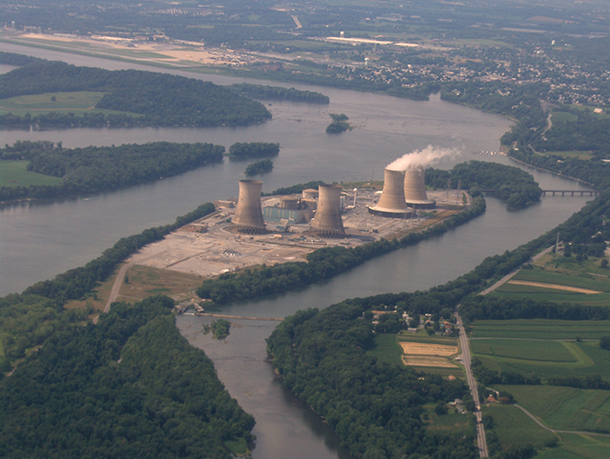
The Three Mile Island disaster was contained because the concrete shell enclosing the reactor core was able to withstand a hydrogen explosion and fire. (Photo: Todd MacDonald, Flickr CC BY 2.0)
The Entergy Corporation recently announced it would soon close two aging nuclear power plants in the US Northeast. Yet the Nuclear Regulatory Commission also granted the company a new license to operate a Tennessee reactor. Nuclear energy expert Arjun Makhijani discusses with host Steve Curwood the paradox and the viability of nuclear power in the current energy landscape.
Transcript
CURWOOD: From the Jennifer and Ted Stanley Studios at the University of Massachusetts Boston and PRI, this is Living on Earth. I’m Steve Curwood. Two of America’s aging nuclear power reactors are shutting down, thanks to safety concerns that have led to rising costs in the face of lower electric power revenues. Entergy’s Fitzpatrick nuclear power plant on Lake Ontario near Syracuse, New York, will close before the end of the decade, as will the same company’s Pilgrim Nuclear Power station near Boston, Massachusetts. In the face of growing safety problems, cheap natural gas and rising use of renewables, both plants lose money. To put the nuclear power landscape into perspective we turn to Arjun Makhijani, President of the Institute for Energy and Environmental Research, and former nuclear engineer.
CURWOOD: Welcome back to Living on Earth, Arjun.
MAKHIJANI: Well thank you so much, Steve, for asking me back.
CURWOOD: Why is Entergy closing down these two plants within a month?
MAKHIJANI: Well these two plants have something in common. They're both single reactor sites. They're both very old which means it takes a fair amount of money to keep them going, repairing the reactors, replacing old parts, and the cost of power generally has been going down while the cost of operating these old reactors has been going up, and those lines have crossed and so these reactors are losing money and so Entergy's closing them down.
CURWOOD: Let's talk about Pilgrim here. It was considered, I understand, to be one of the three least safe nuclear power reactors in the US. Why did it become considered to be so dangerous?
MAKHIJANI: Well, first of all, the boiling water design is similar to Fukushima, and we're all aware of the vulnerabilities of that design. They don't have the kind of robust secondary containment that say Three Mile Island had, which is really what saved us from massive releases of radioactivity during that accident in 1979.
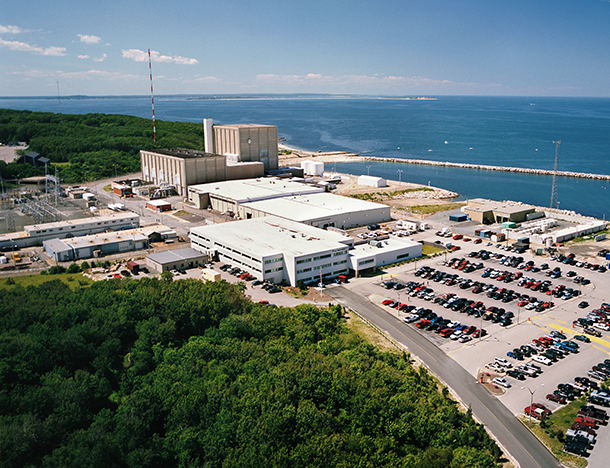
Entergy will close Pilgrim Nuclear Generating Station, on Cape Cod Bay, within four years. (Photo: Entergy Nuclear, Flickr CC BY-NC-ND 2.0)
CURWOOD: Wait, are you saying that if what happened at Three Mile Island happened at the Pilgrim reactor, the city of Boston would've been contaminated?
MAKHIJANI: Well, possibly, yes, because what happened at Fukushima was a hydrogen explosion that blew apart those buildings. There was also a hydrogen fire/explosion at Three Mile Island, but because it had that extremely robust thick concrete containment building, the fire was contained on the inside and the pressure increase was withstood by a containment building and there wasn't a massive release of radioactivity. The gases were released, but not the kind of release that occurred at Fukushima.
CURWOOD: Now, Entergy's also closing the Fitzpatrick nuclear power plant on Lake Ontario, it's near Syracuse. How safe is that plant?
MAKHIJANI: Well it's a similar design, and there are similar safety concerns at Fitzpatrick. Part of the problem is at these single reactor plants, the costs have been going up and the tendency to economize on maintenance is great, and so the safety margins in these reactors tend to decline and that creates problems.
CURWOOD: Now, as I understand it, Governor Cuomo in New York says he'd rather see the Indian Point reactor near New York City closed down instead of the Fitzpatrick. What do you think of his reasoning?
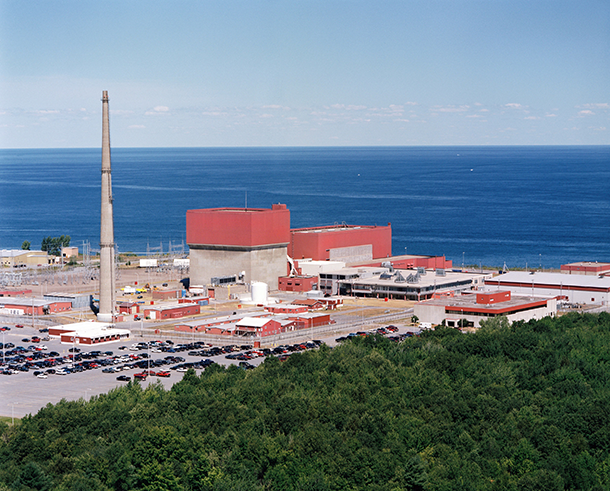
The Fitzpatrick Nuclear Power Plant, which is on the shores of Lake Ontario in New York state, will close in about a year. (Photo: Entergy Nuclear, Flickr CC BY-NC-ND 2.0)
MAKHIJANI: Well, you know Indian Point is very close to the biggest city in the United States, and so I think it's reasonable to see a faster closure to Indian Point, but I think Syracuse should not be less precious to the governor. I think the company has said it's losing money and wants to close it and I don't think the governor should be asking for the reactor to be open.
CURWOOD: Well, that plant has a lot of tax revenue. I saw a story saying it's worth north of $10, $15 million a year to the community nearby.
MAKHIJANI: Well this is the problem that is emerging, Steve, these plants do give tax revenue. They keep the schools and fire departments and police departments going, and they tend to be in rural communities and it's giving these companies leverage to basically ask for more and more subsidies. I think a two-prong remedy is necessary rather than keeping old clunky nuclear power plants going. One is we should have a community and worker protection fund, a small charge on nuclear electricity that can be used to protect workers from unemployment ,transition them into new employment. You know we give companies incentives to come, but they are to be a kind of a pension fund for communities when they die or leave. Another part of the solution of course is that this plant can and should be replaced by efficiency and renewable energy that can create a lot of tax revenues and jobs.
CURWOOD: Arjun, the Pilgrim nuclear generating station in Massachusetts provides 84 percent of the carbon free electricity in the state. Now, how significant will its closure be in terms of the state's production of low carbon electricity?
MAKHIJANI: Well you know it's true that like in Massachusetts and many areas nuclear is a significant part of the low carbon electricity, but it's also true that these plants are shutting down because they're very high cost. The highest cost nuclear plants cost more than $60 a megawatt hour to operate. Today you can buy wind power for $30 a megawatt hour and even after the tax credit expires you'll be able to buy it for $50 a megawatt hour. Why should we be spending $60 and $70 and $80 a megawatt hour for old power plants that are generating waste that we don't know what to do with instead of simply going to renewable energy? We should move more rapidly to anticipate that these old nuclear power plants are becoming costly, they've closed down and we should accelerate our renewable energy effort so we don't have these blips in carbon production when they do retire.
CURWOOD: The announcement that these two nuclear power plants will be closed, the announcement coming really in just the past month, what is that say about the viability of nuclear energy today?
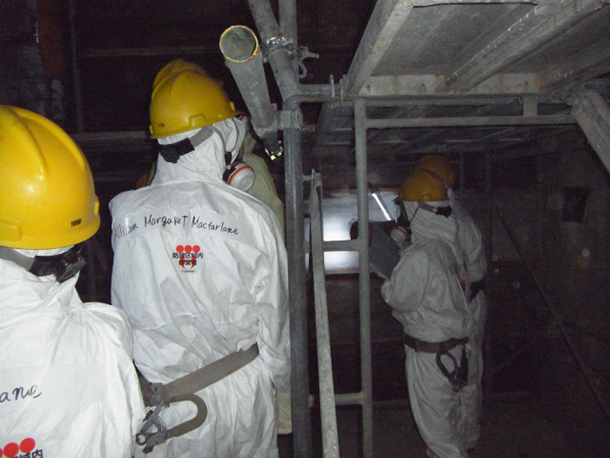
Nuclear Regulatory Commission officials visit Reactor 4 at the Fukushima Dai-ichi nuclear complex. (Photo: TEPCO, Flickr CC BY 2.0)
MAKHIJANI: A large part of the US nuclear fleet is becoming very high cost. According to the statistics of the Nuclear Energy Institute itself, the average costs of operating these reactors have increased by about 40 percent in the last eight years. That's a sign of aging and the need for some safety improvements. I think many of the reactors that are at single reactor sites or has had other features that are high-cost features are really on the way to not being competitive or already are not competitive. I don't see a very good prognosis for nuclear energy in this country.
CURWOOD: Now, just a few weeks ago the Nuclear Regulatory Commission granted a request to begin generating electricity at a nuclear reactor in Tennessee.
MAKHIJANI: Right.
CURWOOD: Now given that you told us that nuclear power really is on the way out because of competitive pressures, how is this possible?
MAKHIJANI: Well this is not a new reactor. This is a really old reactor whose construction was started more than 40 years ago in the 1970s and then its construction was abandoned more than 20 years after that in 1996, restarted in 2007 when we were promised that it would be finished for $1.5 billion if I'm recalling correctly and in four years, and it has taken eight years and $4.5 billion. This is one of the least safe pressurized water reactor designs that the NRC should never have licensed for operation in the 21st century. It has features that are different than the Three Mile Island plant we talked about which had that robust containment. This particular design, the Watts Bar 2, has been regarded as 100 times more likely to have an early containment failure compared to other pressurized water reactors like Three Mile Island. It should be a scandal that the NRC has allowed this design to be licensed at this time.
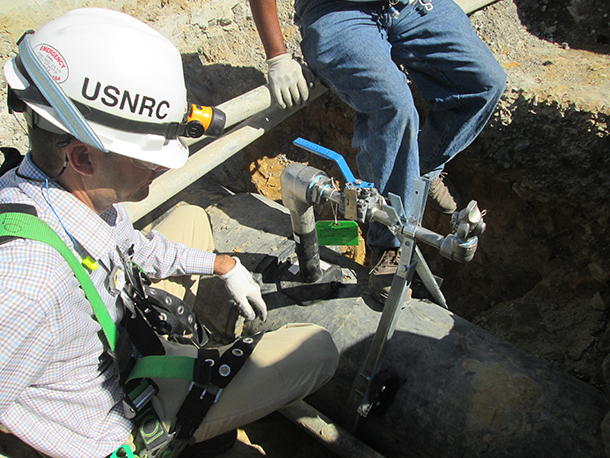
An NRC Resident Inspector observes modifications to the Watts Bar Unit 2 reactor, meant to prevent a disaster similar to what happened at Fukushima. (Photo: Nuclear Regulatory Commission, Flickr CC BY 2.0)
CURWOOD: Arjun, how safe is the newest nuclear reactor technology? If somebody wanted to build one of these things with the best technology we know today, how safe would it be?
MAKHIJANI: They are much safer than the Watts Bar reactor overall. They have some vulnerabilities. The main problem with nuclear reactors is the design of the fuel that leads to meltdowns and hydrogen generation and the potential for explosions. I raised this question with the Nuclear Regulatory Commission in the post-Fukushima discussions. Why have you not addressed the design of the fuel rods that creates this vulnerabilities of large amounts of hydrogen and hydrogen explosions?, and they said, “well it's a common vulnerability of all these designs and so we didn't address it”. I would've thought, if this is a common vulnerability, we should address it, and there are ways to address it, but there you are.
CURWOOD: In any event would the new style reactors be competitive in this particular energy price environment?
MAKHIJANI: They are not. We have four new reactors being built, two in South Carolina and two in Georgia. Wall Street refused to finance them. They are being built by laws that were passed by the states legislatures to require ratepayers to pay for their construction without any risk to the company. If the reactors are not finished then the ratepayers don't get their money back, and you know in the last phase of nuclear power, about 100 reactors were started or planned and not finished. If the reactors are finished even though the ratepayers finance them, they don't get to own a piece of it, and typical as the last go around, the costs have gone up and there have been significant delays.
CURWOOD: Someone listening to us will say, “what about the question of nuclear waste, Mr. Makhijani? New reactor, old reactor, they still generate this stuff, and we don't seem to have a solution for that. Why should we even be talking about nuclear power if we can't solve the waste problem?”
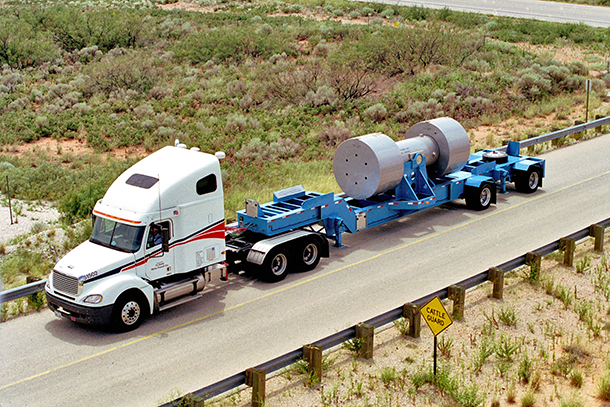
Nuclear waste being transported to a deep geologic repository near Carlsbad, NM. (Photo: Department of Energy, Flickr CC BY 2.0)
MAKHIJANI: This is a very good question and the answer is that we shouldn't be talking about it. We should think of phasing them out and limiting the amount of nuclear waste and getting on with a nuclear repository program that makes sense. Now, it's not a good solution but it's the least bad solution. We cannot leave this nuclear waste lying around at more than 60 sites forever. Currently, the Nuclear Regulatory Commission’s position, however, bizarre it might sound is that we can leave these wastes at power plant sites forever, that it will be safe despite the fact that it has plutonium in it that lasts for tens of thousands of years. We're farther away from a sensible repository program than we were in 1982 when the Nuclear Waste Policy Act was passed.
CURWOOD: So Entergy says it's going to shut down the Pilgrim plant in Massachusetts, the Fitzpatrick plant in New York State. What exactly does “shutting down” that is “decommissioning” a nuclear power plant entail?
MAKHIJANI: Well this is a long tale. So, the spent fuel, the used nuclear fuel, which is highly radioactive, will remain in the pools. It may be moved to dry storage. Dry storage in some ways is safer but creates its own issues. There's nowhere to put it, of course, so the site cannot be decommissioned completely. Decommissioning is expensive because the reactors are highly radioactive, or parts of the reactors are very, very radioactive, so it takes a lot of time, effort and care to dismantle these machines. There are wastes generated from that, and so they'll have to work out a decommissioning plan. Some of these plants are just sitting around to be decommissioned later. I do think it is better to move on with decommissioning. You keep workers employed and there's some taxes that arise out of that.
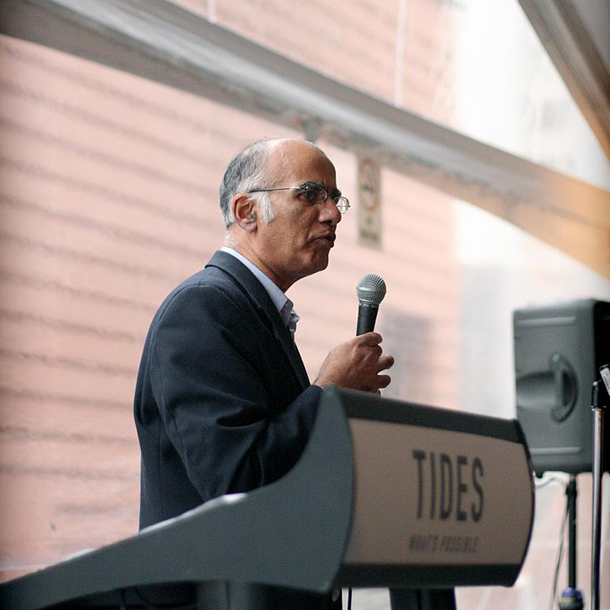
Arjun Makhijani is the President of the Institute for Energy and Environmental Research. (Photo: Francisco Martinez/Tides Momentum, Flickr CC BY-NC-ND 2.0)
CURWOOD: Now my perception would be that even though decommissioning takes a long time, and there's a lot a radioactive material that stays on site, that nonetheless it lowers the risk for the surrounding public in comparison to an operating aging nuclear plant. How correct is my perception?
MAKHIJANI: You're absolutely right. There are mainly two different kinds of big risks associated with nuclear power. One of them, of course, we have seen dramatically in Fukushima is that operating nuclear reactor fails, has a meltdown and massive release of radioactivity. That is the risk that goes away when you shut down the nuclear reactor and remove the fuel. When you remove the fuel to the spent fuel pool where it is stored, you still have some risks because some of this fuel is still pretty hot and it needs to be cooled, so you can have a loss of coolant, and there are some risks of fires if you have a complete loss of coolant, but as the fuel gets older it cools down significantly and these risks do decline, and if you thin out these pools and have dry storage, the risks to the surrounding population become quite low.
CURWOOD: Arjun Makhijani is the President of the Institute for Energy and Environmental Research in Tacoma Park, Maryland. Arjun, thanks for taking the time with us today.
MAKHIJANI: Thank you so much, Steve, for asking me back.
Links
The only nuclear plant in Massachusetts to close
Entergy to Close Fitzpatrick Nuclear Power Plant in New York
Say Hello to the First New U.S. Nuclear Plant in Almost 20 Years
Half-death: Nuclear power emits no greenhouse gases, yet it is struggling in the rich world
Nuclear power plants warn of closure crisis
Carbon-Free and Nuclear-Free: A Roadmap for U.S. Energy Policy by Arjun Makhijani
Living on Earth wants to hear from you!
Living on Earth
62 Calef Highway, Suite 212
Lee, NH 03861
Telephone: 617-287-4121
E-mail: comments@loe.org
Newsletter [Click here]
Donate to Living on Earth!
Living on Earth is an independent media program and relies entirely on contributions from listeners and institutions supporting public service. Please donate now to preserve an independent environmental voice.
NewsletterLiving on Earth offers a weekly delivery of the show's rundown to your mailbox. Sign up for our newsletter today!
 Sailors For The Sea: Be the change you want to sea.
Sailors For The Sea: Be the change you want to sea.
 The Grantham Foundation for the Protection of the Environment: Committed to protecting and improving the health of the global environment.
The Grantham Foundation for the Protection of the Environment: Committed to protecting and improving the health of the global environment.
 Contribute to Living on Earth and receive, as our gift to you, an archival print of one of Mark Seth Lender's extraordinary wildlife photographs. Follow the link to see Mark's current collection of photographs.
Contribute to Living on Earth and receive, as our gift to you, an archival print of one of Mark Seth Lender's extraordinary wildlife photographs. Follow the link to see Mark's current collection of photographs.
 Buy a signed copy of Mark Seth Lender's book Smeagull the Seagull & support Living on Earth
Buy a signed copy of Mark Seth Lender's book Smeagull the Seagull & support Living on Earth

